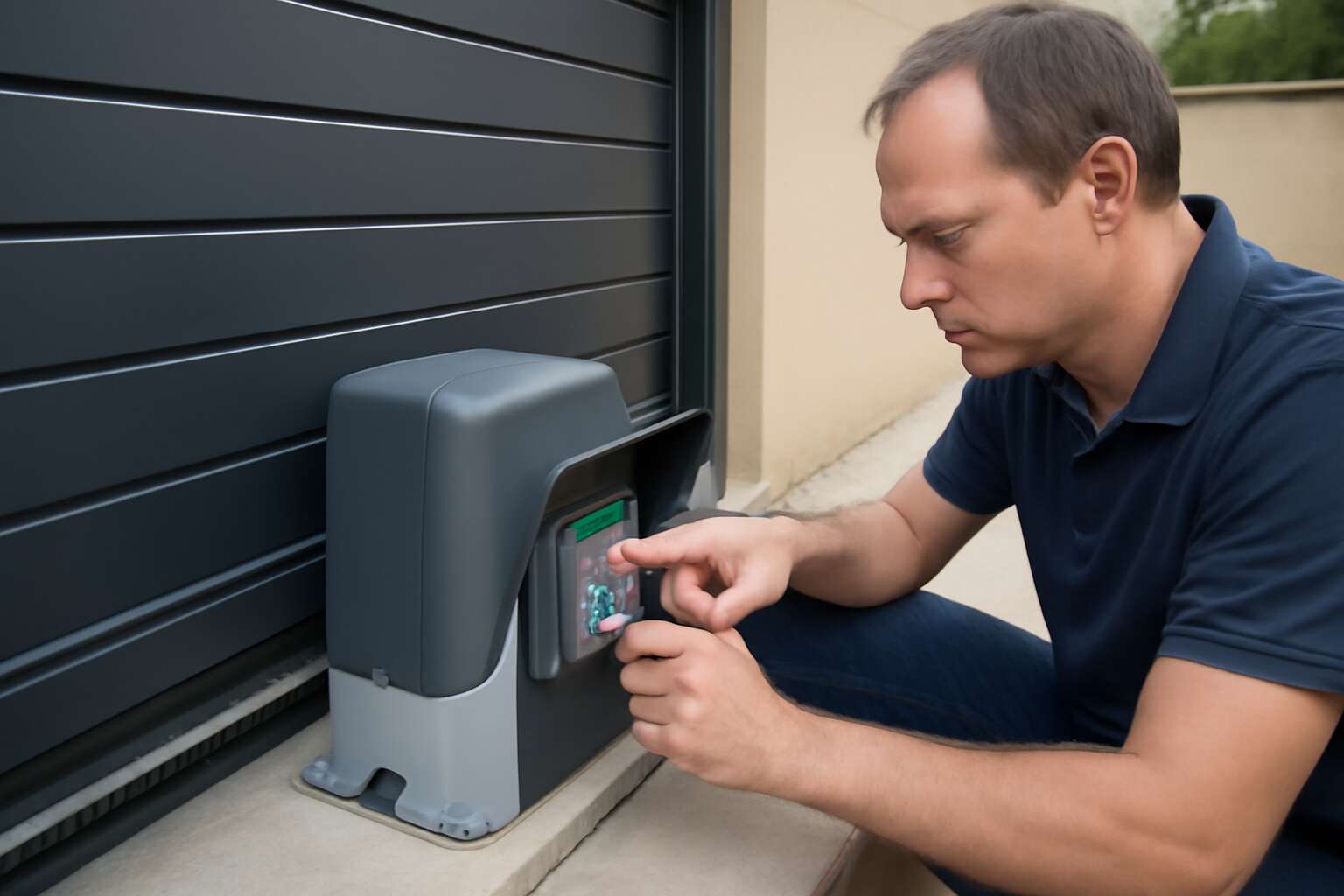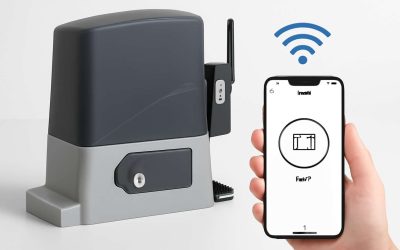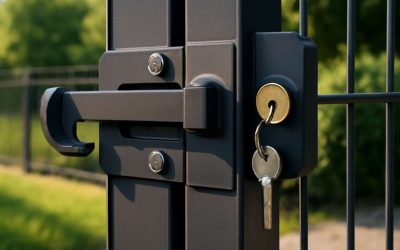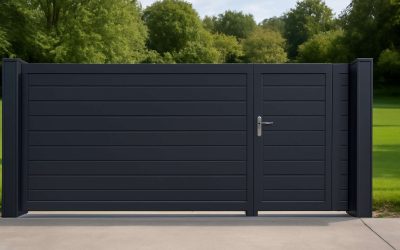Common Causes of Sliding Gate Malfunctions
Mechanical Issues – Problems with Gate Track, Rollers, or Wheels
When a sliding gate not working becomes an unwelcome obstacle, the root often lies beneath the surface, hidden in the realm of mechanical issues. Over time, the intricate dance of moving parts can falter, leading to frustrating stalls and sluggish responses. One of the most common culprits is wear and tear in the gate track, which acts as the backbone of smooth operation. When debris or misalignment occurs, the entire system can grind to a halt, leaving homeowners perplexed and vulnerable to security concerns.
Similarly, problems with rollers or wheels are frequent offenders. These components endure relentless stress, and without proper lubrication or maintenance, they can seize or break. When rollers fail, the gate struggles to glide effortlessly, often resulting in a ‘sliding gate not working’ scenario. Regular inspection of these parts can prevent costly repairs and restore the elegance of a smoothly functioning sliding gate system.
Electrical Failures – Power Supply Issues and Faulty Wiring
Electrical failures are often the silent culprits behind a sliding gate not working. Despite the robustness of modern gate systems, power supply issues can cause sudden, inexplicable halts. Faulty wiring, for example, can disrupt the flow of electricity, rendering the entire automation system useless. It’s as if the gate has been cursed—stuck in place, refusing to obey commands. In some cases, the problem originates from an inconsistent power source or a blown fuse, leaving the gate completely unresponsive when you need it most.
Understanding the intricacies of electrical failures is crucial. Often, the solution involves inspecting the wiring connections or assessing the power supply.
- Check for loose or corroded wiring connections
- Ensure the circuit breaker hasn’t tripped
- Test the transformer for functionality
When these elements falter, the entire gate system comes to a grinding halt, transforming an otherwise seamless entrance into a frustrating obstacle. The mystery of the sliding gate not working deepens when electrical faults lurk beneath the surface, waiting to strike at the most inconvenient moments.
Sensor and Safety Device Problems – Misaligned or Dirty Safety Sensors
When a sliding gate refuses to obey, it often feels like an insidious whisper of malfunction, lurking behind the façade of modern automation. Nearly 60% of gate failures are rooted in sensor and safety device issues, yet many homeowners overlook the subtle signs that betray these hidden culprits. Safety sensors, those vigilant sentinels ensuring the gate halts before any unintended intrusion, can become misaligned or coated with dirt—an invisible barrier that sabotages operation. The slightest misalignment can trigger false alarms, causing the entire system to halt, leaving you stranded outside.
Cleaning sensors regularly and ensuring they face each other directly can often resolve these issues. If misalignment persists, it might be time to recalibrate or replace the sensors altogether.
- Dirty or obstructed sensors
- Misalignment of sensor beams
- Faulty safety devices
are common reasons why a sliding gate not working can be frustratingly unpredictable. These seemingly minor faults wield significant power over the gate’s functionality, turning what should be seamless access into an agonizing stalemate. Recognizing these issues early can save time and money, but more often than not, the underlying cause is an overlooked safety sensor problem, lurking beneath the surface of what appears to be a mechanical or electrical failure.
Remote Control and Manual Operation Failures – Dead Batteries or Faulty Remote
Few frustrations rival the silent defiance of a sliding gate not working when you need it most. It’s often the simplest issues that cause the grandest inconveniences—like a remote control that has finally met its match in dead batteries. Despite the sleek exterior, these devices can be surprisingly fragile, and an unassuming power failure might be the reason your gate refuses to respond to your command.
When your remote control fails, it’s tempting to attribute the problem solely to the remote itself. But here’s a nugget of wisdom: sometimes, the culprit is as mundane as a weak battery or a faulty transmitter. A quick swap of batteries can restore harmony, but if that doesn’t do the trick, consider the possibility of a malfunctioning remote or receiver unit.
- Dead batteries
- Faulty remote control
Manual operation is another avenue, yet even that can prove uncooperative if the internal mechanisms are compromised. The key is to inspect whether the remote system is transmitting signals correctly or if internal components have simply given up. When a sliding gate not working persists beyond the basic checks, it’s often a sign that deeper electrical issues—such as faulty wiring or power supply interruptions—are at play. After all, in the world of automation, the tiniest flaw can cause the grandest standstill, turning what should be seamless access into a frustrating dance of troubleshooting.
Troubleshooting Tips for a Non-Working Sliding Gate
Initial Inspection Steps – Checking Power Connection and Remote Control
When your sliding gate not working leaves you stranded in front of your property, a swift initial inspection can often reveal the culprit. Power connection issues are a common obstacle; sometimes, a loose or disconnected power cable is all that’s standing between you and smooth operation. It’s worth checking the power supply at the outlet, ensuring that your circuit hasn’t tripped, and inspecting the wiring for any visible damage.
Next, take a moment to evaluate the remote control. Dead batteries or faulty remote units can easily cause the sliding gate not working as expected. Replacing batteries or testing with a spare remote can quickly determine if this is the root of the problem. Simple steps like these often save homeowners from unnecessary expenses and frustration, especially when troubleshooting a sliding gate that refuses to respond.
Assessing Mechanical Components – Examining Tracks, Rollers, and Gate Alignment
When the sliding gate not working becomes a persistent puzzle, it’s often rooted in the mechanical heart of the system. Sometimes, the simplest oversight—like debris caught in the tracks or misaligned rollers—can halt the entire operation. It’s a silent form of resistance, an obstacle hiding in plain sight that tests patience and intuition alike.
Assessing these mechanical components demands a careful eye. Examine the tracks for obstructions, ensuring they are free of dirt, leaves, or small objects that could impede movement. Check the rollers or wheels for wear and tear; worn-out parts often cause the gate to seize or operate unevenly. Precise alignment is crucial—if the gate isn’t perfectly aligned along its track, it will struggle to open or close smoothly. In some cases, realignment or lubrication restores harmony, but ignoring these details risks further damage and persistent malfunction.
- Inspect the gate’s track for debris or obstructions.
- Check rollers and wheels for signs of wear or damage.
- Ensure the gate is properly aligned along its track for smooth operation.
Understanding the mechanical intricacies of a sliding gate not working isn’t just about fixing a problem—it’s about respecting the delicate balance between human intent and mechanical design. When these elements falter, the entire system’s rhythm is disrupted, and the question remains: how can we restore the silent harmony that keeps our gates functioning seamlessly?
Inspecting Electrical System – Testing Motor, Fuses, and Wiring
When your sliding gate not working, it can feel like a silent guardian has suddenly lost its voice. Beneath the surface, the electrical system’s heart beats with intricate precision, and a disruption here can spell chaos for your access points. Testing the motor, fuses, and wiring is essential to unveil the hidden culprits behind the malfunction. A simple blown fuse or loose wiring connection might be the quiet saboteur, halting your gate’s graceful dance.
To troubleshoot effectively, start with a visual inspection of the motor and wiring harnesses. Look for corrosion, frayed wires, or burn marks that signal electrical distress. Using a multimeter, test the circuit for voltage consistency—any irregularity could be the root of the issue. For a more systematic approach, consider this:
- Check the power supply to ensure electricity reaches the motor.
- Inspect all fuses and replace any that are blown.
- Examine wiring connections for looseness or damage.
Remember, sometimes the solution is as simple as replacing a dead battery in the remote control, but other times, the fault lies deep within the electrical labyrinth. When the sliding gate not working persists despite these efforts, it’s a reminder that a well-tuned electrical system is the silent conductor of smooth operation, demanding careful attention and respect.
Sensor Calibration and Cleaning – Realigning and Cleaning Safety Sensors
When a sliding gate not working, it’s often the safety sensors that are the silent culprits. Over time, dirt, dust, and debris can obscure or impair these vital components, preventing the gate from operating smoothly. Realigning and cleaning the sensors isn’t just maintenance—it’s a safeguard against unexpected failure. A misaligned sensor might be the reason your gate refuses to open or close, turning your daily routine into a frustrating ordeal.
To troubleshoot, carefully inspect the sensors’ positions and ensure they face each other directly. Dirt or spider webs can interfere with the signal, so gently wipe the sensors with a clean cloth. Sometimes, a simple re-calibration is all that’s needed to restore harmony. If your sliding gate not working persists, check for any physical obstructions blocking the sensor’s line of sight—these tiny obstacles can cause big problems.
Remember, safety sensors are the gatekeeper of secure operation. They must be perfectly aligned and spotless to communicate clearly. When these steps don’t resolve the issue, it’s time to consider whether the sensors themselves are faulty or need replacing. The right calibration and cleanliness could be the key to unlocking seamless gate performance once more!
Professional Solutions to Fix a Sliding Gate Not Functioning
When to Call a Gate Repair Specialist – Identifying Complex Mechanical or Electrical Failures
When a sliding gate not working becomes an unyielding obstacle, it’s often a sign that deeper, more complex issues are at play. While routine maintenance can resolve many problems, some failures demand the expertise of a professional gate repair specialist. Electrical failures, for instance, can be elusive—hidden wiring faults or malfunctioning motors may silently undermine the entire system. These issues are not always visible but can cause the gate to remain stubbornly immobile, even when all external connections seem intact.
In such moments, recognizing when to call a gate repair specialist is crucial. If simple inspections of power supply and remote controls don’t restore function, it’s time to consider that the problem might stem from intricate mechanical or electrical failures. A seasoned technician will perform a comprehensive diagnosis, often involving testing the motor and inspecting internal wiring. For those facing a sliding gate not working despite initial troubleshooting, professional intervention can be the key to restoring smooth operation and peace of mind.
Replacing Faulty Components – Motor, Sensors, or Control Boards
When your sliding gate not working turns into an immovable fortress, it’s time to bring in the big guns—professional solutions that go beyond DIY fixes. Replacing faulty components like the motor, sensors, or control boards can often breathe new life into your gate, restoring both functionality and peace of mind. These parts are the heart and soul of a smooth-operating sliding gate, and when they falter, the entire system suffers.
Skilled technicians approach this task with precision, carefully diagnosing the root cause before swapping out what’s broken. For instance, a worn-out motor might be causing sluggish or unresponsive movement, while malfunctioning sensors could be blocking the gate’s ability to detect obstacles. Replacing these components isn’t just about fixing a problem—it’s about ensuring your gate’s longevity and safety.
In many cases, a straightforward replacement of faulty parts such as control boards or sensors can be the difference between a gate that’s stuck and one that’s working flawlessly. An expert will select high-quality, compatible components tailored to your gate’s specific model, providing a long-lasting solution that keeps your driveway secure and operational.
Upgrading Your Gate System – Modern Automation Options and Remote Access
When your sliding gate not working transforms your driveway into a silent sentinel, it’s time to embrace the art of upgrading your gate system. Modern automation options breathe new life into aging mechanisms, blending sophistication with reliability. Imagine the seamless elegance of remote access, where your gate responds to your command with a whisper, no matter the weather or hour. Sliding gate not working can often be remedied by integrating state-of-the-art technology, elevating your security and convenience to new heights.
Advanced automation systems feature intelligent sensors, Wi-Fi connectivity, and sleek control panels that eradicate the frustrations of manual operation. These innovations serve as the backbone of a resilient security fortress—guarding your property while offering effortless access. For those seeking the pinnacle of convenience, upgrading to remote access ensures your gate responds instantly, transforming everyday entry into a luxurious, effortless gesture. The future is here, and it’s waiting to redefine your approach to security and style.
Preventative Maintenance to Ensure Smooth Operation
Regular Cleaning and Lubrication – Maintaining Tracks, Rollers, and Moving Parts
Let’s face it—nothing kills a good mood faster than a sliding gate not working when you need it most. Regular cleaning and lubrication are your first line of defense against this modern-day gate nightmare. Think of your sliding gate as a diva—she demands attention and pampering to perform her best. Dust, dirt, and grime love to settle into the tracks and rollers, turning a smooth glide into an embarrassing grinding halt. A quick wipe down with a damp cloth and some quality lubricant can transform your gate from sluggish to silky-smooth in no time.
Maintaining the tracks, rollers, and other moving parts isn’t just about avoiding hassle; it’s about prolonging the life of your automation system. An easy way to stay ahead is to implement a routine that includes inspecting for debris and making sure all parts are adequately lubricated. For instance, you might consider a simple checklist:
- Clear the tracks of any obstructions.
- Apply a suitable lubricant to rollers and hinges.
- Check for signs of wear or rust.
- Test the gate’s movement after each maintenance session.
By prioritizing preventative maintenance, you ensure your sliding gate remains responsive and reliable. After all, a well-maintained gate is the difference between seamless automation and a frustrating day of manual operation—because nobody wants their sliding gate not working when it matters most!
Annual Inspection – Checking Electrical Connections and Safety Devices
Every seasoned homeowner or business manager knows that a sliding gate not working can turn a seamless entry point into a frustrating barrier. Regular annual inspection is crucial to keep those automated systems running smoothly, especially in South Africa’s diverse climate where dust, moisture, and temperature fluctuations can take a toll. A meticulous check of electrical connections and safety devices ensures that the gate’s heart—its electrical system—remains resilient against unforeseen failures.
During this inspection, pay close attention to the safety sensors and wiring, as misaligned or damaged components can cause the sliding gate not working at the worst moment. An effective approach involves a systematic review, such as:
- Inspecting all electrical connections for corrosion or looseness
- Testing safety devices to confirm they trip correctly
- Verifying that sensors are properly aligned and free of dirt or debris
By dedicating time to thorough annual inspections, property owners can preempt mechanical or electrical faults—avoiding the dreaded scenario where the sliding gate not working hampers daily routines. This proactive stance not only preserves the elegance of automated gates but also fortifies their reliability against the unpredictable elements of life and environment.
Proper Use and Storage of Remote Controls – Battery Care and Signal Range
In the world of automated gates, the remote control is often considered the unsung hero—until it stops working, and suddenly, your sleek sliding gate not working becomes the highlight of your day. Proper use and storage of remote controls are crucial to avoid this common frustration. A poorly stored remote, exposure to dust, moisture, or extreme temperatures can drain batteries prematurely or impair signal transmission, rendering your gate unresponsive.
Careful battery maintenance is key. Regularly check the remote’s batteries and replace them before they die completely—nothing kills convenience faster than a dead remote during a rainstorm! Additionally, keeping the remote’s signal range in mind helps prevent issues. For optimal operation, ensure the remote isn’t obstructed by metallic objects or thick walls, which can weaken the signal and contribute to the sliding gate not working when you need it most.
To streamline remote operation, consider these tips:
- Store remotes in a dry, cool place away from direct sunlight.
- Use high-quality batteries to extend remote life and signal strength.
- Keep the remote’s antenna unobstructed for maximum signal transmission.
By paying attention to remote control care, property owners can avoid those pesky moments when the sliding gate not working turns a routine entry into a hassle—saving time, frustration, and perhaps a few grey hairs!
FAQs for Sliding Gate Malfunctions
Why won’t my sliding gate open or close? – Common Electrical or Mechanical Causes
When your sliding gate not working, it can feel like an insurmountable obstacle—especially when access is suddenly cut off. Surprisingly, many gate malfunctions stem from overlooked electrical or mechanical issues that are easier to diagnose than you might think. Understanding the root of the problem can save you time and money, and prevent further damage.
One common cause of a sliding gate not working is a power supply failure. If the electrical connection is compromised—whether by blown fuses, faulty wiring, or a dead battery in your remote control—the gate won’t respond. Additionally, sensor misalignment or dirt accumulation can interfere with safety devices, preventing the gate from operating correctly. Sometimes, the issue is as simple as a sensor needing cleaning or realignment to restore proper function.
To troubleshoot effectively, consider a systematic approach that includes inspecting electrical components and mechanical parts. For example, examine the motor, check the remote control’s battery, and verify that the gate’s track and rollers are free of obstructions. Recognizing these common electrical and mechanical causes can help diagnose why your sliding gate not working might be a symptom of a deeper issue, waiting to be uncovered.
How do I reset my automatic sliding gate? – Step-by-step Reset Procedures
When your sliding gate not working, the frustration can feel like battling a mythical beast—complex and unpredictable. Yet, many issues can be resolved with a simple reset, restoring harmony to your automated barrier. Resetting your automatic sliding gate is often the key to unlocking its secret powers.
Begin by turning off the power supply to your gate system. This step is crucial to ensure safety and prevent any electrical mishaps. Once powered down, locate the reset button—usually found on the control panel or inside the motor housing. Hold it for about 10 seconds, then release. If your gate has a manual override, engage it to test whether the gate responds to manual commands.
In some cases, you may need to perform a more comprehensive reset by disconnecting the power entirely and waiting for a few minutes. This pause allows the system’s internal memory to clear. After reconnecting the power, test the gate with your remote control or keypad. If the sliding gate not working persists despite these steps, it might be time to explore deeper mechanical or electrical troubleshooting.
- Check the remote control’s batteries—sometimes, a simple replacement is all it takes.
- Ensure the safety sensors are clean and correctly aligned.
- Inspect the power supply and wiring connections for signs of wear or damage.
When these measures don’t resolve the issue, consulting a professional gate repair specialist in South Africa can prevent further complications. Remember, even the most enchanted sliding gates occasionally need expert intervention to regain their full strength and agility.
Is it safe to repair my sliding gate myself? – Safety Considerations and When to Seek Professional Help
When your sliding gate not working, it can evoke a strange sense of helplessness—like a trusted guardian suddenly rendered immobile. Is it safe to attempt repairs yourself? The answer hinges on the complexity of the issue and your familiarity with electrical and mechanical systems. While some minor adjustments may seem tempting, the inherent risks of electrical shock or further damage often outweigh the potential benefits of a DIY fix. It’s essential to recognize your limits and prioritize safety above all else.
For instance, if your sliding gate not working is due to issues with the motor, wiring, or safety sensors, these components involve high-voltage connections that can pose serious hazards. In such cases, consulting a professional gate repair specialist in South Africa is prudent. They possess the expertise and tools to diagnose and resolve complex mechanical and electrical failures efficiently and safely.
However, if the problem appears to be simple, like dead batteries in the remote control or dirty safety sensors, some basic troubleshooting can be undertaken.
- Replacing remote batteries
- Realigning safety sensors
- Checking for loose wiring connections
Remember, attempting to repair a sliding gate not working without proper knowledge can lead to personal injury or further damage, ultimately complicating the situation. When in doubt, it’s always wise to seek professional assistance, ensuring your property remains protected and your peace of mind intact.




0 Comments